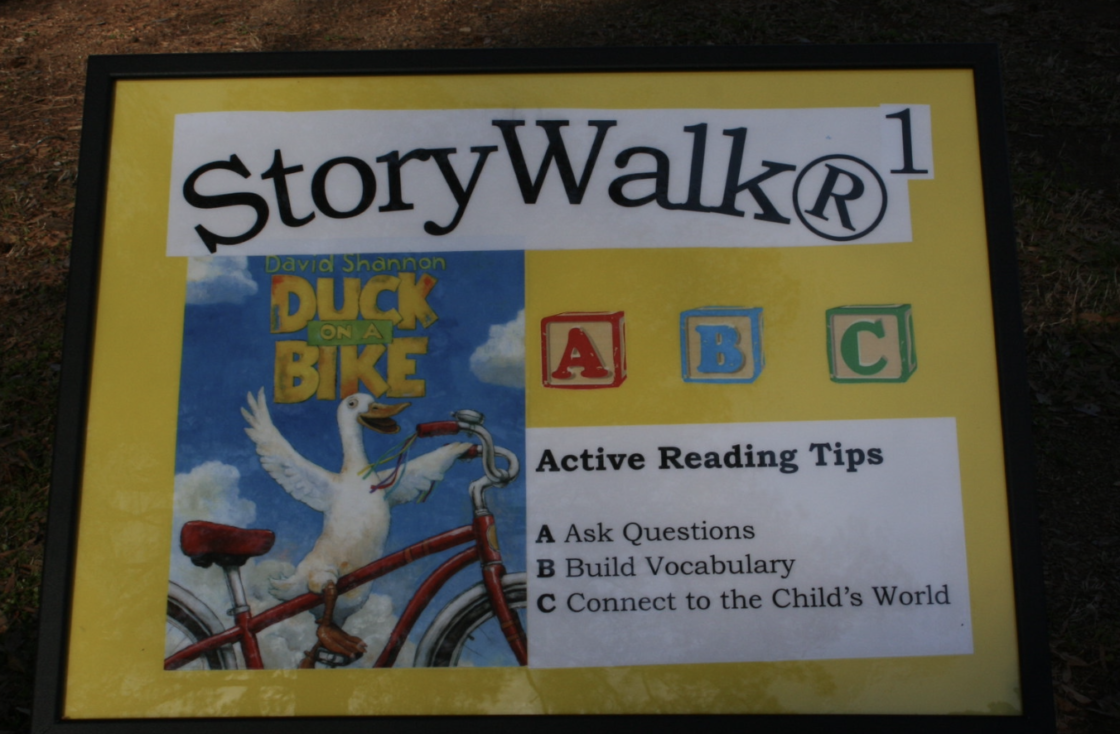My school is PreK through 8th grade and for many years when my librarian friends gushed about their One Book One School initiatives I would sigh and look a little wistful. Our students had such a wide range of developmental levels it truly didn’t seem possible. How can one book be as meaningful to preschoolers as fourteen year olds? It is the same problem I butt up against when once a month our building meets in “houses” and that same age range of students group together for some type of shared activity for the purposes of character education and community building. In those cases I aim for about 4th grade and the older students have to help the youngest. It’s not ideal but it works. Then came the storywalk!
In case you are unfamiliar with storywalks, let me give you a little background. Librarians Anne Ferguson and Rachel Senechal of the Hubbard-Kellogg Library of Montpelier Vermont had the great idea to obtain multiple copies of books the library owned, ideally in big book format, take them apart, laminate them, and post them outside on wooden stakes so patrons could walk while reading a story, ideally a title that connects with the area in which the book is displayed. This would be another venue in which families could explore reading together even when not at the library.
At our school, in the immediate post-covid timeframe, we found some social skills, and quite frankly some empathy for one another had been lost. Looking for ways to reconnect the school I approached our administration with the idea of posting a storywalk that older students could read to younger ones. There was pushback that students outside of homerooms shouldn’t be mixing and from maintenance not wanting to mow around signs. Being persistent, I proposed that I instead, post a book in storywalk in the halls around our building, and that I would develop a unique set of questions for each grade band that focused on social-emotional learning. Our assistant principal was a former middle school English teacher and she offered to be my proofreading/ brainstorming partner for this literacy adventure. I knew the book I wanted to share immediately, Last Stop on Market Street by Matt de la Pena. I had taught this book on the story rug to littles and had used it as a mentor text for older students previously. It had a positive message that could resonate on different levels.
With a little research I discovered that Prindle Institute for Ethics had created a lesson plan available for use under Creative Commons licensing which I combined with some visual thinking strategy discussion, and some questions that laser focused on some of the behavior challenges we were facing. Here is an overview of how the questions leveled:
Grades PreK-K compared and contrasted how people on the bus were similar and different from one another and how people at school were similar and different to one another. They also looked at how Nana gave up her seat on the bus to someone who was blind and the things we do at school when others are having challenges.
Grades 1-2 compared and contrasted CJ and Nana’s attitude about the challenges they encountered. They also reflected on the passage about how Nana “finds beautiful” where CJ doesn’t think to look and discussed how we can find beauty in our classmates.
Grades 3-4 looked at how people’s lives seemed different from one another and asked if one life was worth more than another based upon what they could or could not do. They also discussed when we should do or should not do special things for people who are different than ourselves. They also discussed the inequity they observed.
Grades 5-6 looked at the empathy and where it was shown in the story. They also looked at the motivation of CJ and Nana volunteering at the soup kitchen. They debated if some reasons for volunteering are better than others. They also dived into the differences between equity and equality and what those should look like at school and in the community.
Grades 7-8 made the challenging leap of observing the differences between sympathy, empathy, and solidarity and asked themselves if attitude makes these shifts easier or more difficult.
I could not have been more pleased with the discussions teachers reported back to me about their storywalks. After the success of this venture, I have created additional whole building discussion guides for other mentor texts. Have you done anything similar in your school community? Do you have a favorite all ages social emotional learning title I should add to my collection? Keep the conversation going in the comments.

